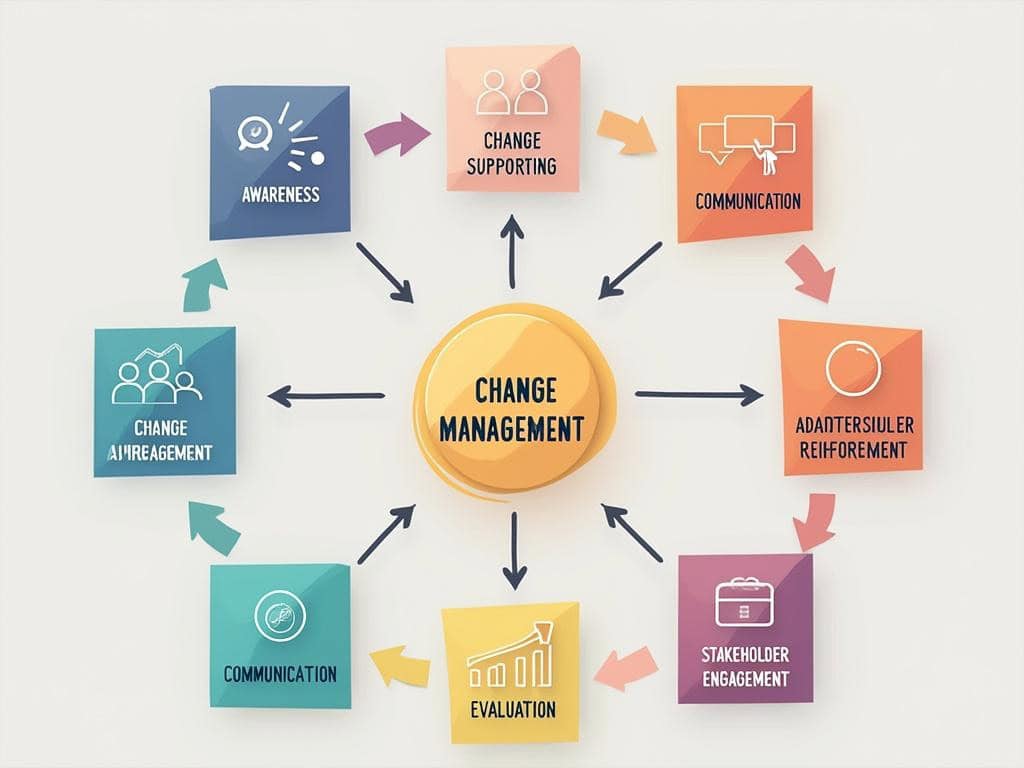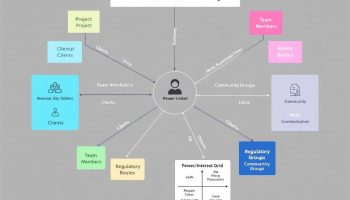
The Change Management Cycle
The change management cycle creates a structured framework that helps organizations implement transformations systematically, moving from current operations to desired future states. When you properly execute a comprehensive change management cycle, your organization can effectively manage both technical systems and human responses, making you seven times more likely to achieve project goals compared to organizations using unstructured approaches.
Key Takeaways:
- The change management cycle involves interconnected stages including awareness, planning, implementation, reinforcement, and evaluation.
- Strong leadership support and clear communication are critical for successful organizational transformation.
- Adaptability and flexibility within the change management framework allow for responsive strategy adjustments.
- Different types of organizational change (adaptive and transformational) require tailored management approaches.
- Continuous monitoring and stakeholder engagement are essential for sustaining long-term change initiatives.
Proper implementation of change management models can significantly reduce resistance while accelerating adoption rates. Your organization’s ability to adapt depends on how effectively you prepare teams for upcoming shifts. Understanding the complete cycle helps you identify potential roadblocks before they impact your implementation timeline.
Each phase of the change cycle builds upon previous steps, creating momentum that carries the organization forward. Leadership commitment remains essential throughout the process, as executives must demonstrate consistent support for initiatives to gain traction across departments. Effective change programs incorporate feedback mechanisms that allow for course correction based on real-time performance data and stakeholder input.
Organizations that excel at change management create dedicated teams responsible for coordinating activities across the change management cycle. These specialists develop specialized communication plans tailored to different audience segments within the company. They also establish clear metrics to track progress and identify areas requiring additional attention.
The psychological aspects of change deserve as much attention as procedural elements. Resistance stems from natural human responses to uncertainty and perceived threats to job security. Addressing these concerns through transparent communication and empathetic leadership helps employees transition from resistance to acceptance and eventually advocacy for new approaches.
“The change management cycle empowers organizations to navigate the complexities of transformation with a structured approach, enhancing their chances of success by effectively addressing both technical and human elements. By fostering strong leadership, clear communication, and adaptability, organizations can transform challenges into opportunities for meaningful progress.”
Overview of Change Management
The change management cycle represents a structured approach to transitioning individuals, teams, and organizations from current states to desired future states. You’ll find it’s a critical component in today’s fast-paced business landscape where adaptation isn’t just beneficial—it’s essential for survival. Organizations that implement a formal change management cycle are 7 times more likely to meet their project objectives compared to those without structured approaches.
The change management cycle provides a framework that helps you navigate organizational transformation systematically. This process involves several key phases that guide your transition through assessment, preparation, implementation, and reinforcement. Each phase of the change management cycle builds upon the previous one to create sustainable transformation.
Understanding the Change Management Cycle Phases
The change management cycle typically follows these interconnected stages:
- Awareness and Assessment: Identify the need for change and evaluate your current state
- Planning and Preparation: Develop detailed change management cycle strategies and secure resources
- Implementation: Execute the change while managing resistance and adaptation
- Reinforcement: Solidify new behaviors and prevent regression to old patterns
- Evaluation: Measure results against objectives and identify lessons learned
When implementing the change management cycle, you should develop strategic plans that address both technical and human aspects of change. The technical side involves processes, systems, and structures, while the human side focuses on behaviors, attitudes, and cultural shifts. Both elements require equal attention in the change management cycle to achieve success.
Effective change management cycle strategies require strong leadership support. As leaders, you must visibly champion the change, communicate its importance, and model the desired behaviors. Without this crucial sponsorship, even the most meticulously planned change management cycle initiatives often falter.
Communication plays a pivotal role throughout the change management cycle. You should create comprehensive communication plans that address stakeholder concerns, explain the rationale for change, and provide regular updates on progress. Organizational change management success largely depends on how effectively you communicate during each phase of the cycle.
Remember that the change management cycle isn’t linear but iterative. You’ll need to continuously assess progress, gather feedback, and adjust your approach as needed. This flexibility within the change management cycle framework allows you to respond to unforeseen challenges and opportunities that inevitably arise during transformation efforts.
Expert Insight: To effectively navigate the change management cycle, prioritize a structured approach by understanding the interconnected phases: Awareness and Assessment, Planning and Preparation, Implementation, Reinforcement, and Evaluation. Strong leadership support and clear communication are essential; leaders must actively champion the change and address stakeholder concerns to foster engagement and minimize resistance. Embrace the iterative nature of the cycle, continuously assessing progress and adapting strategies to overcome challenges and capitalize on new opportunities for sustainable transformation.
Types of Organizational Change
Understanding the change management cycle is essential for successful transformation initiatives. You’ll need to recognize different types of change to select the right approach and strategy. The change management cycle helps you structure your transformation efforts systematically, ensuring they deliver lasting results.
Key Categories of Organizational Change
When implementing the change management cycle, you’ll encounter two primary types of organizational change:
- Adaptive Change – These are incremental adjustments that occur gradually within your organization:
- Workflow updates that enhance efficiency
- Policy modifications to address new regulations
- System upgrades that improve existing processes
- Procedural refinements to eliminate bottlenecks
- Transformational Change – These represent large-scale, often sudden shifts that fundamentally alter your organization:
- Launching entirely new business units
- Complete structural redesigns
- Major technology implementations
- Mergers and acquisitions
- Comprehensive culture transformations
Understanding these distinctions helps you develop effective strategic planning for your change initiatives. Each type requires different applications of the change management cycle, resource allocations, and leadership approaches.
The change management cycle provides a framework that adapts to both types of change. For adaptive changes, you’ll focus on targeted communication and specific training. For transformational changes, you’ll need comprehensive stakeholder analysis and extensive support systems.
Organizations that tailor their change management cycle to the specific type of change are 7 times more likely to meet their project objectives. This highlights why identifying your change type early is crucial for success.
Your approach to resistance will also vary depending on the change type. Adaptive changes typically face less resistance as they build on existing frameworks. Transformational changes often encounter stronger pushback, requiring more intensive active listening and engagement strategies throughout the change management cycle.
The complexity of your change management cycle should match the complexity of your change initiative. Simple, adaptive changes can use streamlined cycles, while transformational efforts need more robust frameworks with additional checkpoints and validation steps.

Preparing for Change
Effective preparation forms the backbone of any successful change management cycle. You’ll need to thoroughly assess your organization’s current state before implementing transformational initiatives. This preparation phase is crucial—it sets the foundation for all subsequent activities in the change management cycle.
A comprehensive impact assessment helps you identify potential challenges and opportunities. Start by analyzing your organizational structure, processes, and culture to understand how the proposed changes will affect different departments and teams. You’ll need to map out dependencies and identify potential resistance points to develop strategies that address them proactively.
Developing clear, measurable goals aligned with strategic priorities gives your change management cycle direction and purpose. These goals should follow the SMART framework (Specific, Measurable, Achievable, Relevant, Time-bound) to ensure they provide meaningful guidance. For example, rather than stating “improve customer satisfaction,” a better goal would be “increase customer satisfaction scores by 15% within six months through the implementation of new service protocols.”
Creating stakeholder engagement plans is essential for effective project collaboration. You should identify all stakeholders affected by the change and classify them based on their influence and interest. This classification helps you tailor communication strategies for each group. Consider these stakeholder engagement approaches:
- Conduct one-on-one meetings with key influencers
- Host department-wide information sessions
- Create feedback channels for concerns and suggestions
- Develop targeted messaging for different stakeholder groups
- Establish regular update schedules throughout the change management cycle
Leadership commitment serves as the cornerstone of successful change initiatives. Without visible, active sponsorship from senior leaders, change efforts often falter. You must secure this commitment early and maintain it throughout the change management cycle. Leaders should consistently demonstrate their support through words and actions, allocating necessary resources and removing organizational barriers.
Building Your Change Management Strategy
Your primary deliverable during the preparation phase is a detailed change management strategy. This document outlines how you’ll navigate the entire change management cycle from initiation through implementation and sustainability. The table below shows the key components to include:
| Strategy Component | Purpose | Key Considerations |
|---|---|---|
| Vision Statement | Clarifies the desired future state | Must be compelling and easy to communicate |
| Scope Definition | Establishes boundaries of the change | Prevents scope creep during implementation |
| Resource Plan | Identifies required personnel and budget | Should include contingency allocations |
| Risk Assessment | Catalogs potential obstacles | Include mitigation strategies for each risk |
| Success Metrics | Defines how progress will be measured | Must be quantifiable and tracked regularly |
By thoroughly preparing for change, you’ll increase your chances of successfully executing your projects and driving meaningful organizational transformation through the change management cycle.
Organizations that successfully manage change experience 70% better project outcomes than those that do not.
forbes.com
Implementation and Execution
The implementation phase of the change management cycle forms the bridge between planning and results. You’ll need clear strategies to navigate through resistance and ensure your change initiative succeeds. Effective execution requires methodical planning, robust communication, and continuous adjustment to maximize adoption rates.
Strategic Planning for Successful Change Implementation
Detailed planning serves as the foundation for successful change implementation. Your change management cycle should include specific action steps that break down large-scale changes into manageable components. Consider these essential elements:
- Develop comprehensive implementation timelines with clear milestones
- Assign specific responsibilities to team members across departments
- Create contingency plans for potential roadblocks or resistance
- Establish key performance indicators to measure implementation progress
- Allocate appropriate resources for each stage of the change management cycle
Communication plays a vital role in addressing resistance during the change management cycle. You should develop targeted messaging for different stakeholder groups to address their specific concerns. Consistent communication helps prevent rumors and builds trust throughout the organization.
Resource management becomes critical during implementation. You must identify potential resource gaps early and develop strategies to address them before they impact your implementation timeline.
Testing and piloting changes using the Plan-Do-Check-Act (PDCA) framework allows for iterative improvements before full-scale rollout. This approach minimizes disruption and builds confidence in the change management cycle’s effectiveness.
Training programs should be designed to build the specific skills needed for the change. Consider using a mix of delivery methods to accommodate different learning styles. The right project collaboration techniques can significantly improve implementation effectiveness.
Feedback mechanisms must be established to capture real-time insights during implementation. This information helps you make necessary adjustments to the change management cycle and demonstrates responsiveness to employee concerns.
When leading implementation, you’ll need to balance adherence to the change management cycle with flexibility. The ability to adapt your approach based on emerging challenges will significantly increase your success rates. Organizations that effectively execute their change management cycle are 7 times more likely to achieve their project objectives.
Organizations that effectively execute their change management cycle are 7 times more likely to achieve their project objectives.
forbes.com
Embedding and Sustaining Change
Successfully implementing change is only half the battle in the change management cycle. You need to ensure new processes become firmly rooted in your organization’s DNA. Without proper embedding strategies, your carefully orchestrated transformation can quickly unravel, wasting resources and damaging morale.
Creating Sustainable Change Management Practices
The change management cycle requires consistent reinforcement to prevent regression to old habits. Here’s how you can solidify new practices:
- Continuous Performance Monitoring: Track key metrics to measure adoption rates and identify areas needing additional support.
- Behavior Reinforcement Programs: Implement recognition systems that reward employees demonstrating the desired behaviors.
- Cultural Integration Strategies: Align new processes with existing organizational values to accelerate acceptance.
- Feedback Mechanisms: Establish channels for ongoing input to refine implementations based on real-world experiences.
- Knowledge Transfer Systems: Create documentation and training resources to preserve institutional knowledge.
Preventing regression demands vigilance. When effective project communication begins to falter, employees may drift back to comfortable but outdated practices. The change management cycle includes monitoring for signs of backsliding and addressing them promptly through targeted interventions.
Building change resilience into your organizational fabric requires developing institutional capabilities. This involves equipping managers with change management skills and establishing dedicated change champions across departments. These individuals become the guardians of your transformation, maintaining momentum when attention naturally shifts to newer initiatives.
Successful organizations treat change management as an ongoing discipline rather than a one-time event. By embedding change strategies in an organisation, you create a foundation for future adaptability. This change management cycle approach yields lasting results rather than temporary improvements.
The integration of new processes with existing systems is critical for sustainability. When changes complement rather than disrupt workflows, resistance decreases substantially. Evaluate your technology infrastructure, reporting relationships, and operational procedures to ensure alignment with your change management cycle initiatives.
Remember that embedding change isn’t a passive process. It requires active management and ongoing attention to the change management cycle. By treating sustainability as a core objective rather than an afterthought, you dramatically increase your transformation’s long-term impact and return on investment.
Strategic Benefits and Best Practices
The change management cycle delivers substantial advantages when properly executed. You’ll find that implementing a structured approach transforms potential disruptions into strategic opportunities. Organizations that follow a well-defined change management cycle experience 7 times higher success rates in meeting project objectives compared to those using ad hoc methods.
Key benefits of an effective change management cycle include reduced resistance, accelerated adoption, and improved return on investment. When you implement the cycle methodically, you’ll notice employees adapt more quickly to new processes while maintaining productivity levels. This systematic approach also helps organizational change management teams identify potential obstacles before they derail progress.
Critical Success Factors
Several essential elements must be present throughout the change management cycle to ensure positive outcomes:
- Strong leadership commitment that demonstrates visible support for changes
- Comprehensive stakeholder analysis and targeted engagement strategies
- Clear, consistent communication that addresses the “why” behind changes
- Adequate training and development resources to build necessary capabilities
- Measurement systems that track progress against defined success metrics
Your change management cycle should incorporate regular feedback loops to allow for course corrections. This iterative approach creates opportunities to address emerging challenges before they become significant barriers. Establishing a continuous improvement mindset helps reinforce the change management cycle as an ongoing process rather than a one-time event.
The most effective change management practitioners recognize that different organizational contexts require customized approaches. You’ll need to adapt the change management cycle to fit your specific culture, structure, and change readiness levels. Conducting a thorough organizational assessment before launching initiatives helps calibrate your change management cycle for maximum effectiveness.
Remember that the change management cycle doesn’t end with implementation. Building mechanisms to sustain changes over time is equally important. This includes developing change champions, integrating new processes into performance management systems, and celebrating successes to reinforce desired behaviors.
Implementing Change: Next Steps and Recommendations
After designing your change management cycle, you’ll need to put your plans into action with strategic implementation. The change management cycle requires careful execution to ensure your organizational transformation achieves its intended outcomes.
You should select a change management model that aligns with your specific needs. Popular frameworks include Kotter’s 8-Step Process, ADKAR, and Lewin’s Change Management Model. Each offers different approaches to guiding the change management cycle through its various phases. Your choice should reflect your organization’s culture, the scope of change, and available resources.
Building organizational change capabilities is essential for sustainable transformation. This involves:
- Training dedicated change champions across departments
- Developing standardized change management methodologies
- Creating reusable change management templates and tools
- Establishing metrics to track change progress and effectiveness
- Investing in change management skills for project managers and leaders
A culture of continuous improvement forms the foundation of successful change management cycle implementation. You’ll achieve better results by fostering an environment where change becomes part of your organizational DNA rather than a disruptive event. This requires recognizing and rewarding adaptability, encouraging experimentation, and normalizing constructive feedback.
Measuring Change Management Effectiveness
Tracking the impact of your change management cycle provides crucial data for refining your approach. The following table outlines key metrics to consider:
| Metric Type | Examples | Purpose |
|---|---|---|
| Adoption Metrics | User adoption rates, compliance with new processes | Measures actual implementation |
| Performance Metrics | Productivity changes, error rates, efficiency gains | Evaluates business impact |
| Sentiment Metrics | Employee satisfaction, resistance levels, stakeholder feedback | Gauges human response |
| Capability Metrics | Change readiness scores, leadership effectiveness | Assesses organizational maturity |
Long-term strategies for maintaining organizational adaptability should be integrated into your project leadership approach. This includes developing change management cycle expertise across your organization, establishing governance structures for change initiatives, and creating feedback mechanisms to continuously refine your change processes.
The change management cycle isn’t complete without proper documentation and knowledge transfer. Create comprehensive records of change impacts, lessons learned, and successful strategies. This institutional knowledge becomes invaluable for future transformations and helps avoid repeating past mistakes during your next change management cycle implementation.






